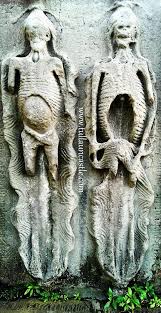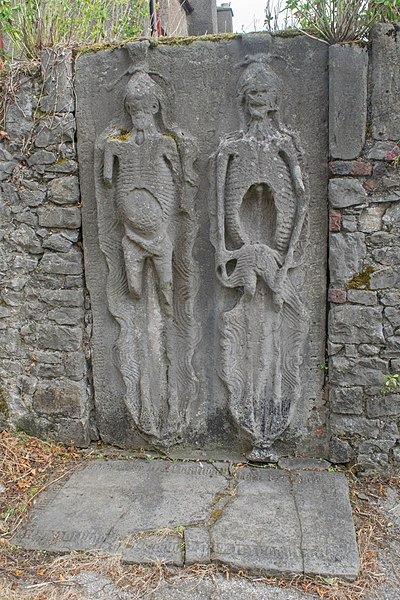In the tranquil setting of St Peter’s Church of Ireland in Drogheda, Republic of Ireland, lies a haunting relic from the past: the cadaver tomb of Edmond Goldyng and his wife Elizabeth Fleming, dating back to approximately 1500-1525. This stone slab, standing seven feet tall, is one of less than ten such stones that survive in Ireland today. It serves as a poignant reminder of the inevitable fate that awaits all, regardless of rank or status.
A Rare Survivor of Medieval Ireland

The cadaver tomb of Edmond Goldyng and Elizabeth Fleming is a rare and significant artifact from medieval Ireland. Such tombs were designed to illustrate the concept of “memento mori”—a reminder that death is the great equalizer. Despite one’s wealth, power, or social standing, everyone ultimately faces the same end. This tomb is especially notable for its detailed carvings and its symbolic representation of mortality.
The Tomb’s Grim Depictions
The stone slab features the skeletal representations of both Edmond and Elizabeth. Elizabeth’s skeleton is uniquely marked by a hole where the womb would be, a stark reminder of the mortality associated with childbirth and the female condition during that period. These carvings are not just artistic representations but also convey deep symbolic meanings about life, death, and the human condition.
Historical Context and Significance
Originally, the stone slab would have been placed atop the grave of Edmond and Elizabeth. However, during the church’s reconstruction in 1757, the slab was moved and placed upright in the churchyard wall. This movement might have contributed to its preservation, allowing it to survive through the centuries as a witness to medieval funerary practices and beliefs.
Cadaver Tombs: A Reflection on Death

Cadaver tombs like that of Edmond and Elizabeth were common in medieval Europe. They were often commissioned by wealthy individuals who wished to remind future generations of the transient nature of life and the certainty of death. These tombs usually depicted the deceased in a state of decomposition, emphasizing the physical decay that follows death. This stark portrayal served as a moral lesson about humility and the ephemeral nature of earthly achievements.
The Legacy of Edmond Goldyng and Elizabeth Fleming
The cadaver tomb in St Peter’s Church not only commemorates the lives of Edmond Goldyng and Elizabeth Fleming but also provides a window into the religious and cultural attitudes of their time. The detailed and somewhat macabre depiction of their skeletal forms speaks to a medieval preoccupation with death and the afterlife, and the belief in the importance of preparing for one’s eternal fate.
Conclusion
The cadaver tomb of Edmond Goldyng and Elizabeth Fleming stands as a rare and evocative relic of medieval Ireland, offering profound insights into the historical context and cultural attitudes toward death. As we contemplate this somber artifact, we are reminded of the universal truth it represents: death is the ultimate equalizer, a fate that unites all humanity regardless of their station in life. This tomb, with its detailed carvings and symbolic imagery, continues to tell the story of mortality and the human condition, bridging the gap between the past and the present in the serene churchyard of St Peter’s Church of Ireland.
